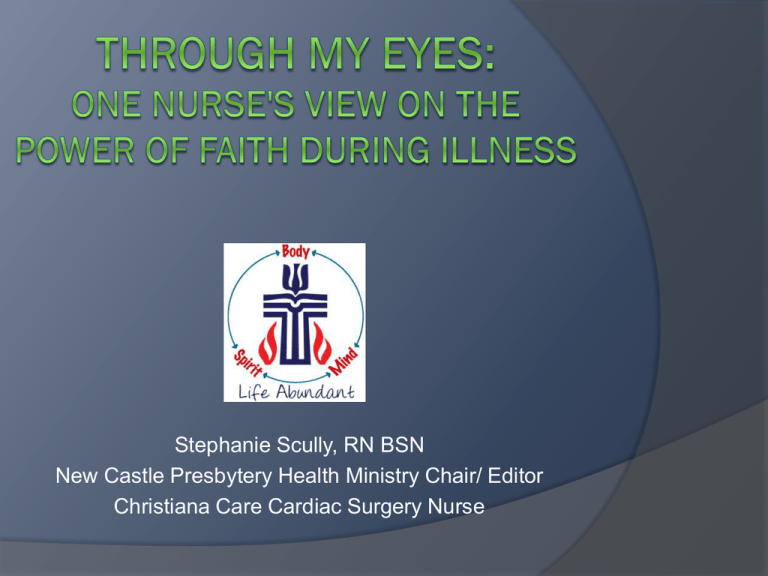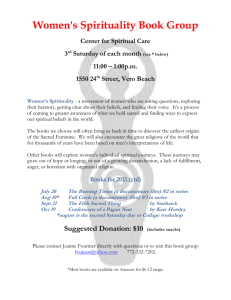
Stephanie Scully, RN BSN
New Castle Presbytery Health Ministry Chair/ Editor
Christiana Care Cardiac Surgery Nurse
Why Present this Topic to Church
Leaders
The Book of Order
Services for Wholeness
“Healing was an integral part of the
ministry of Jesus which the church has
been called to continue as one dimension
of its concern for the wholeness of
people. Through services for wholeness,
the church enacts in worship its ministry
as a healing community.”
Objectives
To display the importance of trust and meaning while
caring for ill patients
To describe the spiritual roots of nursing
To define spiritual health, spirituality, and faith in the
context of science
To understand the concepts of holism and holistic
health in relation to a person’s well-being
To explain the manifestations, causes, and ways to
manage spiritual distress in the hospital setting
To identify ways in which religious leaders can most
effectively promote spiritual health in the hospital and
home setting
To recognize the importance of addressing spiritual
care needs in the community after hospitalization
Roots of Nursing
Florence Nightingale
1820-1910
The mother of nursing
Protestant training
○ A Call from God
Spirituality
○ Entailed the development of courage,
compassion inner peace, creative insight, and
other “God-like qualities”
○ Endorsement of contemplative prayer
Roots of Nursing
Other connections to religion
Betty Neuman and Jean
Watson
○ Spirituality impacts
development
○ Define holistic health
Watson
○ Nurses should respect and
appreciate the spiritual meaning
in a person’s life
Roots of Nursing
Early 1980s- the turning point
Trend away from religion and spirituality
focus in nursing
○ Providing holistic care
1978- NANDA
Nursing diagnosis
○ Spiritual Distress
Spiritual Health
Holistic nursing perspective
Biopsychosocial being
Spiritual core
Components of the self
○ All integral to and
influences the others:
Physical
Mental
Social
Spiritual
○ Spiritual aspects contribute to individuality and
create meaning in people’s lives.
Spiritual Health
What is Spirituality?
The quality or essence
that pervades, integrates,
and transcends one’s biopsychosocial
nature
An experience for connection to life, a way
of interpreting life events; a source of hope,
joy, comfort and guidance on life’s journey
Includes all behaviors that give meaning to
life and provide strength to the individual
Provides balance
Spiritual Health
Characteristics of
Spirituality
Holism
○ Sense of wholeness and harmony
Spiritual Need
○ Seeking meaning
Spiritual Quest
○ A higher level of consciousness
Spiritual Well-Being
○ Positive affirmations, celebrate wholeness
Spiritual Health
Faith
More than a set of beliefs
Way you act out your beliefs
Making meaning– central idea
What needs do faith
and spirituality fulfill?
○ Meaning to life
○ Sense of security
○ Guide daily life
○ Acceptance vs rejection
○ Support
○ Strength
Spiritual Health
Why is understanding spirituality of an
individual important?
A person’s inner strength comes from
different sources
○ Navajo
Harmony
○ Christians
God
○ Tailor your care
Caring for patients (hospitalized or not)
means caring for families and friends as well
Spiritual Health
Statistics
Of the major religions in
the world…
○ 33% are Christian
○ 21% are Islamic
○ 16% are Atheist, Agnostic, or nonreligious
○ 14% are Hindu
In the United States…
○ 76.5% are Christians
○ 13.2% are Nonreligious/ secular
○ 2.3% are Jewish
○ 0.5% each are Hindu, Islamic, Agnostic, and
Buddhist
Spiritual Health
Relation to Nursing
Crisis and change
○ Transitions are times of anxiety and
vulnerability
○ Front row seat
○ Comforting patients
**EXAMPLE: PRAYER
SHAWL , DEATH/DYING
RITUALS I HAVE SEEN
Spiritual Health
Why should healthcare providers assess
spirituality in the healthcare setting?
Greater well-being
Coping mechanisms
Physical manifestations
○ Lower levels of mortality
○ Less heart disease
○ Lower blood pressure
○ Less depression
○ Lower stress levels
○ Less alcohol and tobacco abuse
○ Greater well-being and optimism
○ Positive health habits
Impact on Patient Care
Why does spiritual distress occur?
Questions about meaning
Problems coping
Anger
Sleep disturbances
Separation from religious practices
Treatments challenging beliefs
Impact on Patient Care
Challenges hospitalized patients face
End of life decisions
○ Family members’ beliefs
Blood transfusions
Medications
Minor surgeries
**EXAMPLE: Blood refusal form,
discussions about heart valves
Impact on Patient Care
Manifestations of Altered Spiritual
Function
Verbalization of distress
Altered behavior
○ Nervous
○ Introspective
○ Emotion response
○ Seek information
○ Denial of situation
○ Signs of guilt, fear, depression, or anxiety
Impact on Patient Care
Nurturing the Spirit
Assessing spiritual status- questions
○ What is strength for you? Where can you get it?
○ Who gives you strength?
○ How can you increase your inner strength?
○ What does peace mean to you? Where do you feel at
peace?
○ Who makes you feel more peaceful?
○ What situations increase your sense of peace?
○ When do you feel most secure?
○ Where do you get your security from? Does someone
make you feel more secure?
○ How can you increase your security?
Impact on Patient Care
Barriers
A persistent barrier to the
incorporation of spirituality into
clinical practice is the fear of
imposing particular religious
beliefs and values on others
Remain open
Let the client guide the discussion
and tell you what THEY need
**EXAMPLE: COWORKER’S
STORY
The Gaps I See
Spiritual Assessments
Questions nurses ask
○ **EXAMPLE: CHRISTIANA’S ASSESSMENT
Reality vs. Practice
○ Shift from vocation to profession
Justifying a nurse’s “VALUE”
○ Increase in economic orientation
Where YOU can help
○ Filling the gaps
○ My sacrifice
○ My suggestion
Increase awareness of spiritual health
Increase the population’s spiritual well-being
Importance of Follow-Up
“Hustle-Bustle Nursing”
NANDA diagnosis for “Spiritual Distress”
○ What can nurses do NOW?
Rapid turnover of patients
- What is actually done?
- Consult pastoral care
- Consult psych
- Suggest calling a religious leader
No followup post-discharge
Acknowledge spiritual pain
Be there, now
Importance of Follow-up
Spiritual care
Ongoing process
Relationships over time
Community based care– leadership
initiatives
○ Not just “religious based”
Development of a sensitive spiritual relationship
○ Parish nursing
Health promotion in faith communities
○ Missionary nursing
Promoting holistic health globally
How You Can Help
Key: A warm and trusting relationship
Sharing values
Offering compassion, kindness, gentle
words, and a supportive presence can be life
changing for someone in need
Spiritual Care
A mutual potentially healing or integrating
process in which an individual’s spiritual
needs are met
How You Can Help
Spiritual Health Promotion
Use of Self
○ Availability
Spiritual Support
○ Diverse audience
Support of Spiritual Practices
○ Special religious
considerations
○ Privacy
How You Can Help
Spiritual Health Interventions
Respecting and encouraging a person’s
spiritual and religious interest and concerns
enhances the healing process
○ Listen and Support
Empathy and sensitivity
○ Refer
To others as necessary
○ Tailor your Care
Infants and parents
Age-appropriate
○ Presence
**EXAMPLE: HOLDING HANDS, PRAYER
BEFORE INDUCTION
How You Can Help
Caring and spirituality are central
among faith-based organizations
CIRCLE Model of Spiritual Care
Caring
Intuition
Respect for religious beliefs and practices
Caution
Listening
Emotional support
How You Can Help
Alternative therapiesSpiritual Connection
Prayer and Meditation
Imagery
○ Especially while
hospitalized
Relaxation exercises
Quiet focus
Controlled breathing
Therapeutic touch
PROGRESSIVE RELAXATION
EXERCISE
https://www.youtube.com/watch?v=h9sM24jdZ1w
How You Can Help
Physical effects of relaxation techniques
over time:
Lower blood pressure
Decrease chronic pain
Increase white blood cell production ->
decreased illness
Decreased dysmenorrhea
REVIEW OF HANDOUTS
109+ Ways to say, “I Care”
Thoughtful gifts
Words that can help
Offering special services (i.e. babysitting)
Outings (take me somewhere)
Special Spirit Lifters
Hospital Visitation
A guide to what you can offer
Visiting Someone in the Hospital
Tips and ideas for visiting someone
Major World Religions and Common Health
Beliefs
How to address individuals of other religious within
the healthcare setting
References
Assessment Technology Institute. (2010). RN community health nursing (Edition 5.0).
Philadelphia: Author.
Catalano, J. T. (2006). Nursing now!: Today’s issues, tomorrow’s trends (5th edition).
Philadelphia: F.A. Davis Company.
Clark, M. J. (2008). Community health nursing: Advocacy for population health (5th
edition). Upper Saddle River, New Jersey: Pearson Prentice Hall.
Cole Jr., A. J. (2008). Visiting someone in the hospital. The Presbyterian Leader, p. 1-4.
Cole Jr., A. J. (2009). Hospital visitation. The Presbyterian Leader, p. 1-2.
Craven, R. F. & Hirnle, C. J. (2009). Fundamentals of nursing: Human health and
function (6th edition). Philadelphia: Lippincott Williams & Wilkins.
Ehman, J. W., Ott, B. B., Short, T. H., Ciampa, R. C. & Hansen-Flaschen, J. (1999,
Aug. 9/23). Do patients want physicians to inquire about their spiritual or religious
beliefs if they become gravely ill? Arch Intern Med, 159, 1803-1806.
Mulder, K. & Jurries, G. (2002). 109+ways to say, “I care”. The Compassionate
Congregation, p. 1-11.
Purnell, L.D. & Paulanka, B. J. (2008). Transcultural health care: A culturally competent
approach (3rd edition). Philadelphia: F. A. Davis Company.
Weber, J. & Kelley, J. H. (2007). Health assessment in nursing (3rd edition).
Philadelphia: Lippincott Williams & Wilkins.







